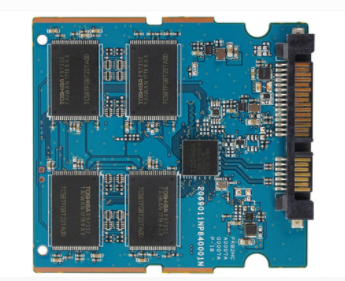The board becomes more and more empty, but it may not be shrinking.
Looking at the development of solid-state drive integration from the PCB layout
The PCB board becomes empty (the number of components decreases) is not necessarily a bad thing, just like the so-called lightning protection chip commonly used on computer motherboards, the lightning protection function of the motherboard has now been integrated into the components of the RJ45 network interface. In the past few years, low-end motherboard manufacturers used independent lightning protection chips (network filters) as their selling point. Now players have seen through this trick of treating backwardness as advanced.
Disassembling a contemporary most advanced 3D flash memory SATA solid state drive, you will most likely see a few flash memory particles, a master chip without DRAM cache. Nowadays, no external cache solution has become the standard configuration of SATA solid-state hard drives. With a small amount of built-in SRAM cache and optimized FTL algorithm, a non-DRAM cache solid state drive such as the Toshiba TR200 can also exert excellent random read and write performance.
The time goes back to three years ago. Toshiba's first-generation 2DTLC solid-state drive Q300, which was just launched at that time, uses an 8-channel master with DRAM cache. The densely arranged flash memory particles make the entire PCB appear very full, but its performance with TR200 is almost There is no difference, even the TR200, which is not as empty as the board in some respects.

The Toshiba RC100, which came out this year, refreshed the public’s impression of solid state drives. There is only one chip on the M.22242 mini PCB, which is obviously the smallest M.2 solid state drive, but it still looks "empty":
We compare the RC100 with the dismantling diagram of a classic SATA solid state drive, and we will find that in addition to the DRAM cache, several other components have also disappeared:
The first is the small black chip in the red box above-serial NOR flash memory. With a capacity of only about 1MB, it carries the role of firmware storage in the solid state drive, similar to the BIOS chip on the motherboard. The main control of contemporary solid-state hard drives has its own ROM space, and the independent NOR flash memory chip is no longer needed.
The external crystal oscillator in the yellow box in the lower right corner of the main controller is another component that is disappearing in the solid state drive. At present, the crystal oscillator on the SSD of most major manufacturers has been integrated into the chip.
Toshiba RC100 has made a major integration of the main control and flash memory. They are packaged in a single particle, which reduces the PCB wiring and makes the overall solid state drive more compact.
In addition to M.22242, it can also be made into a smaller M.22230 specification, and even directly integrated into the motherboard of a thin and light notebook computer.
The Toshiba BiCS3 flash memory used in the RC100 is manufactured using a 64-layer 3D stacking process. The capacity of a single die is 256Gb. Only 16 flash memory dies and the main controller are packaged together to obtain a 480GB NVMe solid state drive with only one chip.
The RC100, which is an NVMe protocol solid state drive, also does not have an external DRAM cache. Through the HostMemoryBuffer host memory acceleration feature of the NVMe protocol, the RC100 only needs to borrow 38MB of host memory to be as efficient as an NVMe solid state drive with external DRAM cache. Work.
With the mass production of 96-layer BiCS4 flash memory and QLC technology, single-chip NVMe SSDs will have the opportunity to achieve 1.33TB of massive storage space in the future. Do you still miss the old SSDs with densely packed components?
iPCB is a high-tech manufacturing enterprise focusing on the development and production of high-precision PCBs. iPCB is happy to be your business partner. Our business goal is to become the most professional prototyping PCB manufacturer in the world. Mainly focus on microwave high frequency PCB, high frequency mixed pressure, ultra-high multi-layer IC testing, from 1+ to 6+ HDI, Anylayer HDI, IC Substrate,IC test board, rigid flexible PCB, ordinary multi-layer FR4 PCB, etc. Products are widely used in industry 4.0, communications, industrial control, digital, power, computers, automobiles, medical, aerospace, instrumentation, Internet of Things and other fields.